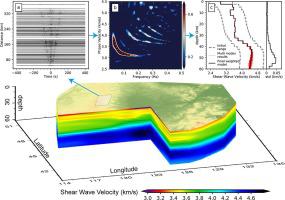当前位置:
X-MOL 学术
›
J. Asian Earth Sci.
›
论文详情
Our official English website, www.x-mol.net, welcomes your
feedback! (Note: you will need to create a separate account there.)
A widespread mid-crustal low-velocity layer beneath Northeast China revealed by the multimodal inversion of Rayleigh waves from ambient seismic noise
Journal of Asian Earth Sciences ( IF 2.7 ) Pub Date : 2020-07-01 , DOI: 10.1016/j.jseaes.2020.104372 Wang Zhan , Lei Pan , Xiaofei Chen
Journal of Asian Earth Sciences ( IF 2.7 ) Pub Date : 2020-07-01 , DOI: 10.1016/j.jseaes.2020.104372 Wang Zhan , Lei Pan , Xiaofei Chen

|
Abstract In this study, we re-examined the crustal and uppermost mantle shear velocity structure beneath Northeast China using the broadband ambient seismic noise data from several temporary and permanent arrays in this region. By employing our newly developed interferometric analysis method (F-J method) for array noises and the corresponding multi-mode dispersion curve inversion approach, we obtained an integrated crustal and uppermost mantle shear velocity model of this region. We divided the study area into 39 overlapping sub-areas and then applied the F-J method to each sub-area to obtain a 3D shear velocity model. We extracted the fundamental mode and up to 4 higher-mode dispersion curves of Rayleigh waves in frequencies ranging 0.02–0.45 Hz from the ambient seismic noise data, inverted multi-mode dispersion curves, and obtained local 1D shear velocity model for each sub-area. By integrating all 1D shear velocity models of the 39 overlapping sub-areas, we obtained a 3D crustal and upper mantle model of Northeast China. Our integrated 3D model shows a widely distributed low-velocity zone at a depth of approximately 10–20 km located beneath the northern part of Xing-Mong orogenic belt and Songliao basin and the Changbaishan Mountain. Moreover, a large high-velocity zone underneath the region around the northern edge of Songliao basin is observed at a depth of approximately 40–50 km depth. These results provide evidence to improve our understanding of the tectonics of Northeast China.
更新日期:2020-07-01









































 京公网安备 11010802027423号
京公网安备 11010802027423号